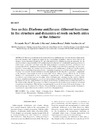Please use this identifier to cite or link to this item:
https://accedacris.ulpgc.es/jspui/handle/10553/49617
| Title: | Sea urchin Diadema antillarum: Different functions in the structure and dynamics of reefs on both sides of the Atlantic | Authors: | Tuya, Fernando Haroun, Ricardo J. Boyra, Arturo Sanchez-Jerez, Pablo |
UNESCO Clasification: | 240119 Zoología marina 240106 Ecología animal |
Keywords: | Sea urchins Reefs Alternate states Regime shifts Community organization, et al |
Issue Date: | 2005 | Publisher: | 0171-8630 | Journal: | Marine Ecology - Progress Series | Abstract: | The long-spined black sea urchin Diadema antillarum has been involved in phase shifts between ‘desired’ and ‘undesired’ states in the organization of shallow reefs on both sides of the Atlantic Ocean between 18 and 33°N, but with significantly different ecological outcomes. In the western Atlantic, high densities of D. antillarum previously exerted considerable grazing pressure on reefs where corals and turf algae were the main biological engineers; however, subsequent to a massive die-off of D. antillarum from disease in 1983–1984, many reefs have gradually become dominated by foliose algae. In contrast, hyperabundances of D. antillarum (>10 ind. m–2) in the eastern Atlantic have caused the elimination of erect vegetative frameworks with the subsequent creation of ‘barrens’. As a result, this invertebrate is directly implicated in the ‘health’ of important components of the biogenic frameworks of reefs on both sides of the Atlantic Ocean. Efforts in the western Atlantic are concentrated on the restoration of populations of D. antillarum to enhance coral abundance, recruitment and survivorship, while ecologists and managers in the eastern Atlantic focus on possible mechanisms to control hyperabundances of this species. We believe that the disproportionate effects of a single herbivorous species in mediating transitions between alternate states on the 2 sides of the Atlantic Ocean may be a direct consequence of a decline in the resilience of coastal ecosystems to disturbance. This decline was principally caused by decreased diversity of many of the functional groups that inhabit the Atlantic Ocean; both the western and eastern Atlantic Ocean have experienced large reductions in predatory and other fish populations. | URI: | https://accedacris.ulpgc.es/handle/10553/49617 | ISSN: | 0171-8630 | DOI: | 10.3354/meps302307 | Source: | Marine Ecology Progress Series [ISSN 0171-8630], v. 302, p. 307-310 |
| Appears in Collections: | Reseña |
Items in accedaCRIS are protected by copyright, with all rights reserved, unless otherwise indicated.
